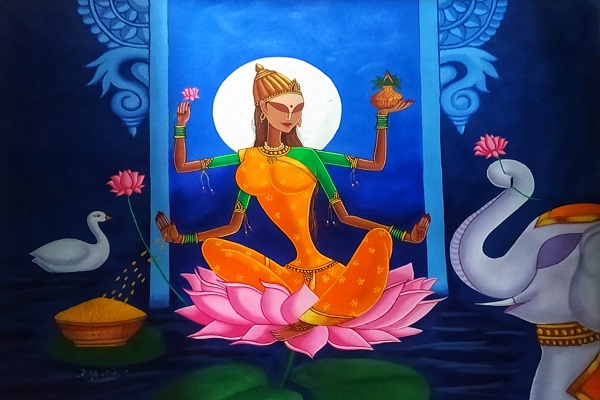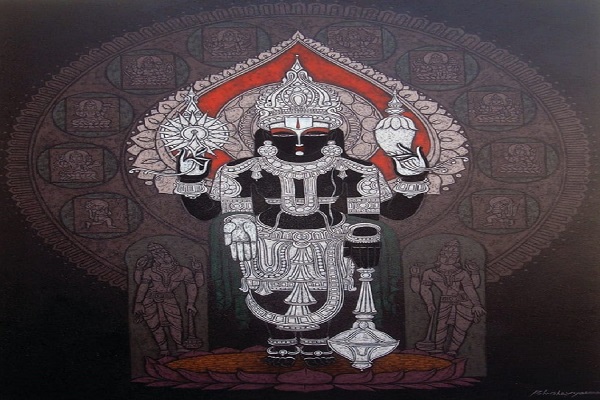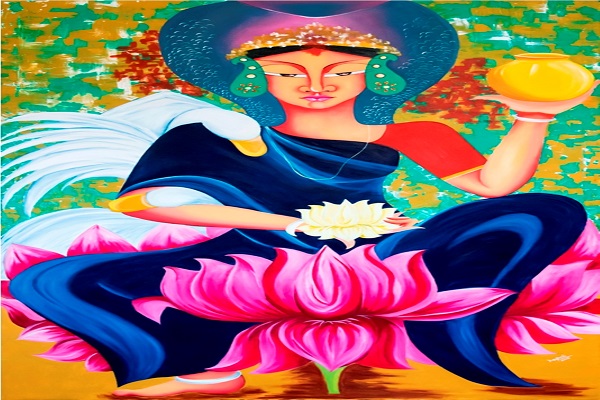
In the tapestry of Indian art, Goddess Lakshmi's presence is as profound as it is intricate. 'Can art convey divinity and wealth?' This question lingers, subtly weaving its way into the very essence of Indian artistic expression. As we delve into the world of Indian artistry, we find that it's not just about colors, forms, and shapes; it's about the profound symbolism that lies beneath the canvas. The legacy of Goddess Lakshmi in this realm is an exploration that unearths the spiritual, cultural, and artistic treasures of India.
Understanding the Iconography of Goddess Lakshmi
Goddess Lakshmi's iconography in Indian art is a profound testament to the cultural and spiritual significance of wealth and prosperity. Her portrayal encapsulates the holistic nature of abundance, encompassing not just financial success but also spiritual enlightenment and the responsibility to share one's blessings. Understanding these symbols enriches our appreciation of the art and the enduring legacy of Lakshmi in Indian culture.
The Aesthetic Allure
Goddess Lakshmi is frequently depicted as a radiant and glorious deity. She embodies beauty and grace, often portrayed with a golden complexion that signifies her connection to wealth. Her four arms are laden with symbolism. On one hand, she carries a lotus, an emblem of purity and enlightenment. The lotus, which grows in muddy waters but remains unstained, serves as a powerful metaphor for rising above worldly attachments.
A Cornucopia of Symbols
At the core of Lakshmi's iconography are a myriad of symbols, each carrying its own profound meaning. The gold coins that flow from her hand represent material wealth, but they also symbolize spiritual wealth. Lakshmi reminds us that prosperity extends beyond mere riches; it encompasses spiritual abundance, virtues, and the wealth of love and compassion.
The Symbolism of the Elephant
In many depictions, you'll notice Lakshmi accompanied by elephants, often showering her with water or carrying vessels of it. The elephant is a symbol of strength, wisdom, and loyalty. In this context, it signifies the strength of character required to bear the weight of prosperity and the wisdom to use wealth responsibly.
A Bountiful Harvest
Wheat sheafs in Lakshmi's iconography symbolize the harvest and the sustenance of life. They remind us that prosperity is not just about amassing wealth but also sharing it for the well-being of all. The blessings of wealth are to be shared generously, just as a bountiful harvest feeds a community.
The Red Sari
Lakshmi is often depicted wearing a red sari. Red is a color associated with sensuality, fertility, and vitality. In this context, it suggests the vibrant and life-affirming nature of wealth and prosperity.
Contribution to Symbolism
These symbols collectively contribute to the overarching message of Lakshmi's presence in Indian art – that wealth, in its truest sense, is not merely the accumulation of riches but an abundance of spiritual and material blessings. Goddess Lakshmi's iconography serves as a reminder of the interconnectedness of material and spiritual prosperity.
Symbolism in Lakshmi's Posture and Gestures

In the realm of Indian art, every stroke of the brush, every chisel mark, and every intricate detail holds a profound purpose. Nowhere is this truer than in Goddess Lakshmi paintings, where her posture and mudras (hand gestures) convey meanings that transcend mere aesthetics.
The Graceful Posture of Lakshmi
Lakshmi, the goddess of wealth, fortune, and prosperity, is often portrayed with a striking posture that embodies grace and beauty. Her seated or standing pose is more than just a visual choice; it carries a powerful message. In her seated form, she is often depicted on a lotus, a symbol of purity, detachment, and the unfolding of the soul. This lotus seat signifies her transcendence over the material world, reminding us that true wealth goes beyond mere material possessions.
Additionally, the four arms of Lakshmi hold various objects, each carrying its own significance. Her lower right hand is often in the Abhaya Mudra, a gesture representing protection, fearlessness, and assurance. Her lower left hand, on the other hand, is often seen in the Varada Mudra, a symbol of blessings, charity, and generosity. Together, these gestures emphasize the idea that true wealth is not just about accumulation but also about the responsible and compassionate use of resources.
The Enigmatic Mudras
Goddess Lakshmi's hand gestures, or mudras, are particularly fascinating. The most common mudra associated with her is the Padma Mudra, where her fingers form a lotus. The lotus is an emblem of purity, enlightenment, and divine birth, underscoring her role in bestowing spiritual wealth.
Another significant mudra is the Abhaya Mudra, seen in her lower right hand, as mentioned earlier. This gesture, with the open palm facing outward, signifies protection and the assurance that the goddess will dispel fear and grant her devotees freedom from all worldly concerns.
Furthermore, the Varada Mudra, with the open palm facing downward, is a symbol of divine blessings and generosity. Lakshmi, in this form, bestows her devotees with the gifts of fortune and abundance. These mudras are profound reminders that true wealth is not just about the accumulation of material possessions but also about the blessings and protection that lead to spiritual prosperity.
Cultural and Spiritual Depth
The symbolism embedded in Lakshmi's posture and gestures extends beyond mere aesthetics. It conveys a profound message about the intertwined nature of wealth, spirituality, and culture in India. Her portrayal serves as a constant reminder that the pursuit of wealth should be coupled with spiritual enrichment and that true prosperity encompasses both material and spiritual dimensions.
Read More: Famous Lakshmi Tanjore Paintings and Their Stories
Goddess Lakshmi in Various Art Forms
Goddess Lakshmi, the epitome of wealth, beauty, and auspiciousness, has been a perennial muse in the vast canvas of Indian artistry. Her presence transcends mere aesthetics, carrying profound spiritual and cultural meanings.
Paintings:
- The Radiant Glow of Raja Ravi Varma
Raja Ravi Varma, a celebrated Indian artist, immortalized Goddess Lakshmi in his painting, "Goddess Lakshmi." Here, she is depicted with four hands, showering blessings and adorning her signature lotus. This iconic masterpiece exudes an aura of divine grace and opulence.
- The Pattachitra Tradition
In the vibrant pattachitra paintings of Odisha, Lakshmi adorns the canvas with her vibrant colors. These traditional artworks often depict her amidst a lotus pond, symbolizing purity and prosperity. The meticulous detailing and intricate motifs make these pieces a visual delight.
- M.F. Husain's Contemporary Interpretation
The modern Indian master, M.F. Husain, breathed new life into Lakshmi's representation. His dynamic and abstract style adds a fresh perspective to the goddess. In his artworks, her form flows with fluidity, embodying the timeless spirit of Indian art.
Sculptures:
-
The Khajuraho Temples
The Khajuraho Group of Monuments, known for their intricate erotic sculptures, also features carvings of Goddess Lakshmi. These sculptures, carved on the exteriors of temples, showcase her in various forms. Each carries a unique message of fertility and prosperity.
- Halebidu's Marvelous Lakshmi
The Hoysaleswara Temple in Halebidu houses a stunning sculpture of Goddess Lakshmi. In this depiction, she stands elegantly on a lotus, symbolizing purity and divinity. The intricate details of her jewelry and attire reflect the craftsmanship of the Hoysala dynasty.
Other Art Forms:
- Tantric Yantras
In Tantric art, Yantras are used as visual tools for meditation. The Sri Yantra, a sacred geometric representation of Goddess Lakshmi, is a profound example of this form. It signifies the union of the divine feminine and masculine, emphasizing prosperity and spiritual growth.
- Kalamkari Art
The ancient Kalamkari art of Andhra Pradesh beautifully captures Lakshmi's grace. Intricately hand-painted on fabrics, these artworks depict the goddess with flowing hair and an enchanting smile, bringing blessings and prosperity to the beholder.

Interesting Blog: Lakshmi Paintings for Home Décor
Wrapping Up
The legacy of Goddess Lakshmi paintings in Indian art goes far beyond the aesthetics. Her depiction is a profound exploration of wealth, spirituality, and culture, reminding us that true prosperity encompasses both material and spiritual blessings. The symbols, postures, and gestures associated with her offer a deeper understanding of the interconnected nature of these dimensions.
Importantly, understanding the symbolism of Goddess Lakshmi in Indian art allows us to appreciate the depth of this cultural heritage. It showcases the enduring significance of wealth, not as mere riches but as an abundance of virtues, responsibility, and the wisdom to use prosperity for the greater good.
As we conclude, we encourage you to explore the rich world of Indian art and delve deeper into the symbolism of Goddess Lakshmi with us. Feel free to visit our Indian Art Ideas website.
FAQs
Who is Goddess Lakshmi in Indian mythology?
Goddess Lakshmi is a revered deity in Hinduism, known as the goddess of wealth, prosperity, and fortune. She represents abundance and is often associated with purity and auspiciousness.
Why is Lakshmi commonly depicted with four arms?
The four arms of Goddess Lakshmi symbolize the four goals of human life in Hinduism – Dharma (duty), Artha (prosperity), Kama (pleasure), and Moksha (spiritual liberation).
What does the lotus in Lakshmi's hand symbolize?
The lotus symbolizes purity and enlightenment. Lakshmi holding a lotus signifies the transcendence over worldly attachments while rising above them unstained.
How has modern artist M.F. Husain depicted Lakshmi in his artwork?
M.F. Husain's contemporary interpretations of Lakshmi offer a dynamic and abstract perspective, infusing fresh vitality into her traditional representation.





















